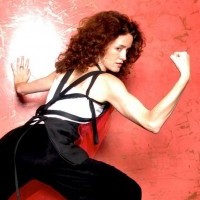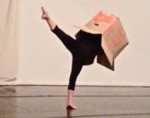
The Geography Trilogy Screening
by Carolyn Merritt
You could slow roast pig bottom to tender, fall-off-the-bone perfection, with plenty of time to prepare sides and dessert, tackle cleaning the bathroom and several loads of laundry as the alchemy of heat, spices, and pork fat permeates your home with an aroma that should probably be outlawed. You could linger over lunch, drinks, and gossip with a friend, get pedicures, grab coffee, go thrifting and upscale window-shopping, or tour more than a couple of museums. You could create your own double feature. Binge watch to your heart’s content. You could do a lot or not so much at all (think Winnie-the-Pooh’s “this is a nothing sort of thing we’re doing right now”) with six-plus hours on a frigid February Saturday afternoon.
I signed up for the screening of Ralph Lemon’s ten-year project, The Geography Trilogy, at Bryn Mawr College. The website advised me of the length, promised I’d be free to come and go. Still, I should have realized that each of the three dance works (plus talkbacks) would be about 2 hours each. I should have factored in my ever-lowering threshold for saturation. Nearly seven hours is a long time to sit in the dark watching dance on film. It is time enough to conjure a list of all the things you could be doing, and to ponder questions big and small. Like why audiences for dance seem to explode in uproarious delight at the music or at comedic theatrical moments, as I witnessed at these screenings, but seldom at the movement. Why dance on film feels an ocean’s distance, more ephemeral than the live thing. Why I feel no trace of energy vibrating through the space and in my body after all this time with these films. (Indeed, at day’s end, I can’t immediately recall the first work.) Whether it is the works themselves or the brutal schedule that sways me from admiration to imprisonment. Why I crave not just the explication of the talkbacks with Lemon, dramaturg Katherine Profeta, and dancer David Thomson, but the breath, texture, weight of real live human bodies, voices, and laughter they provided. Why film is ultimately an impoverished archive for dance. What the recent trend toward book-length treatises (see Ally, The Making Room, Lemon’s Geography trilogy) says about both legacy in dance and what dance is and how it means.
_______________
Geography (n): the study of places and the relationships between people and their environments.
The trilogy’s title evokes early social science efforts to explain human behavior in relation to factors like landscape and climate. Indeed, Wesleyan University Press dubs Lemon “more artistic sociologist than mere traveler” in the jacket of the second installment’s resulting book, Tree: Belief/ Culture/ Balance. From his “exploration into apparent African and post-African connections to his life as an African American” (Part 1: Geography, 1997), to a study of Buddhism’s evolution that “placed the energy and sound of the ‘Africa’ of Geography next to a perceived Asian ‘quiet’” (Part 2: Tree, 2000), to an interweaving of memory, racism, violence, art, and more in the U.S. (Part 3: Come Home Charley Patton, 2004), Lemon’s trilogy is wide ranging in its territorial and thematic scope, while full of moments that feel intimate, individual. It is also chaotic, suffers from repeated false endings, and is desperately in need of pruning. Visually arresting for its large-scale set designs, replete with sufficient technical virtuosity, leisurely in getting where it’s going, often impenetrable without the aid of program notes. That each piece resulted in a book of recollections, sketches, photographs, informal interviews, and more, speaks to just how much Lemon attempted to bite off.
________
Part I: Geography (1997)
Baggy suits make boys of men. Later, their white gowns conjure candomble, spirit possession, syncretism. They scat with their feet, jump and skip as if double dutching sans rope. Tracie Morris’ bilingual poetry and puns interrupt sessions of West African drumming and dancing that are exuberant enough to power a village. The all-male cast includes Lemon, a house dancer from the U.S., and 7 dancers from West Africa and Haiti. Though his original intent was to exchange movement vocabularies, Lemon confesses in the talkback, “they were slapping me in the face with their energy, they didn’t need my body at all.” At moments, Geography reads almost as reverse obliteration in movement, beckoning the question Black Panther’s Danai Gurira recently attributed to the continent itself – “who would we have been if we weren’t colonized?”
Bach’s Goldberg Variations Aria floats through the air, shifts the mood from West African celebration to English teatime restraint. Two dancers face off, then four, then six. A fancy duel on repeat, they take turns tossing their partner to the floor and choking, only to gently lift up and switch roles. The spectacle of these brown bodies role-playing “civilized domination” hints at both mimetic power and the performative nature of colonization. Lemon stands against the back wall and another dancer hurls stones at him. Frenzied, Lemon runs every which way, at each pass throwing his body just out of the stones’ path, like a life-size arcade game.
A bird whistles. Designer Nari Ward’s stage-length coat of armor—a glass-bottle chainlink-fence scrim—descends from the ceiling, casting an eerie net over the action. Chimes clink. From atop ladders, an a capella call and response.
________
Part II: Tree (2000)
A woman talks about leaves, outlines their structure in intimate detail for what feels an eternity. Manoranjan Pradhan, from India, goes on and on in his native tongue. “You understand?” he asks the audience. “No? I’ll speak more slowly,” and he barrels on, more slowly and more loudly. We erupt in laughter along with the crowd on film.
Traditional Japanese banjo music plays. A man sits on a bench, speaks of the “stone in your heart,” “pictures of your life,” how the “ties that bind can choke you.” Dancers David Thomson and Djédjé Gervais argue in French. Asako Takami (Lemon’s partner, now deceased), an Odissi dancer from Japan, recounts a train wreck in her home country. Later, Yeko Ladzekpo-Cole, an African American female dancer, recounts the same story.
Lemon drops stones at his feet and jumps. Tripping over himself, he stumbles to get out of his own way. Held by a harness, Gervais drops from a platform to hover above the ground, just as Thomson flips back to belly on the floor. A female dancer hangs from a harness and screams. Thomson manhandles a female partner as she swings wildly at him.
Car horns, bell chimes, and ambient sounds expand the space. Two female dancers move in hyperslow motion, a storefront Butoh display that stretches time. Each lights a cigarette, and the smoke floats dream-like, voluptuous, igniting a sense of mystery, romance. The browns, coppers, oranges of the mottled metallic backdrop meld before our eyes like sugar burning a path to caramel. Suddenly the whole structure tilts at an angle, dips over one of the dancers. Mr. Lee, an elder Japanese dancer, sings the blues, and we giggle along with the filmed response.
Tree began its journey tracing Buddhism from India to Japan, and evolved into a global work of “cross-cultural pollination” (Lemon, talkback). Manifold languages—of speech and body—converge on a stage peopled by expert dancers from China, Japan, Taiwan, India, West Africa, the U.S., who speak in their native tongues and with their foreign accents. If the movement vocabulary often reads as postmodern, each dancer approaches it from a different vantage point. Translation, mis/communication, conflict are ever present in this mini-Tower of Babel, where even the set and props (Nari Ward again)—grocery store pallets and plastic panel curtains—evoke things in and out of place, the surprise and delight of the (extra)ordinary. Amidst confusion, chaos, even disaster, some things remain, new forms emerge, and the eternal puzzle of the force of identity, divisions, and boundaries shines bright.
________
Part III: Come home Charley Patton (2004)
Video clips open Come Home: horses; Lemon wading waist-high through water, a book in hand; an elder black couple dancing at a juke joint, the camera zooming on their midsections; a talking cartoon head.
Okwui Okpokwasili sings “Ne me quitte pas,” jokes that she is doing Nina Simone doing Jacques Brel doing Jacques Brel. She makes us laugh with her tale of a quirky art teacher, shocks as she detours to schoolground racism. Darrell Jones, David Thomson, and Gesel Mason shuffle, softshoe, swoop and float to the blues in oxfords and khakis. Against the spare white expanse of the wide space, they could be the best Gap commercial yet.
Another video follows an older black Southerner through a tour of his house—past different closets for shirts, pants, and suit jackets; a meat freezer overflowing with turkeys and beef; a tiny TV; several shotguns. It looks like Cuba, just last year.
I have to leave before the conclusion, so I don’t see Lemon get firehosed to the floor, nor do I see him lie down by a street light in Duluth, site of a northern lynching in the 1920s. I miss much of the cartoon character’s speech, and only later do I realize it is James Baldwin reciting excerpts of an essay on race. In the moment, I miss out on much of the meaning of this work intended as a counter-memorial, named for a Delta blues musician, and I am indebted to Google’s archival wonders in the aftermath.
________
At day’s end, I feel as if I’ve traveled through the night with no road map, the mounting impressions piled high, largely undigested.
In a lightly attended event, the crowd evolves as day turns to night, between the films, but few people come and go during each one. As the hours plod on, I waver from transfixed to befuddled to captive to everything in between. The talkbacks function like contextual oases in a sparse landscape; Lemon’s peculiar blend of pomo intellectual eloquence and youthful charm keeps me rooted, hungry for more in spite of my weariness. In its wake, I can’t help but wonder at the purpose of this marathon, when each of the three works has its own Heartbreak Hill moments. I wonder if Lemon himself imagined the trilogy being consumed in this fashion.
As I delve into the archive, my fascination with Lemon deepens. I learn that he got his dancers drunk and high to craft some of Come home Charley Patton. That he pushed dancers through 20-minute non-stop movement drills for a subsequent work. That he lost Takami to cancer after the trilogy, just as he deepened his relationship with Walter Carter, the black Southern centenarian who appeared in Come home. That he had Carter re-enact scenes from the classic Russian sci-fi film Solaris in his next work, How Can You Stay in the House All Day and Not Go Anywhere?
Lemon’s “odyssey” (Walker Art Center) emerged from years of support from Yale University for international travel and research, residencies, workshops, and performances, as well as the Walker co-commission of Come home. It is impossible to imagine such generous, long-range support for such an enormous undertaking at the moment. Equally confounding is the task of plumbing the trilogy’s depths without the generous support of program notes, translation, talkbacks, book-length exposition, and the blood, sweat, and tears of real human bodies bending time and space before you.
The Geography Trilogy Screening, Ralph Lemon, Bryn Mawr College Performing Arts Series, February 3.
By Carolyn Merritt
March 9, 2018









